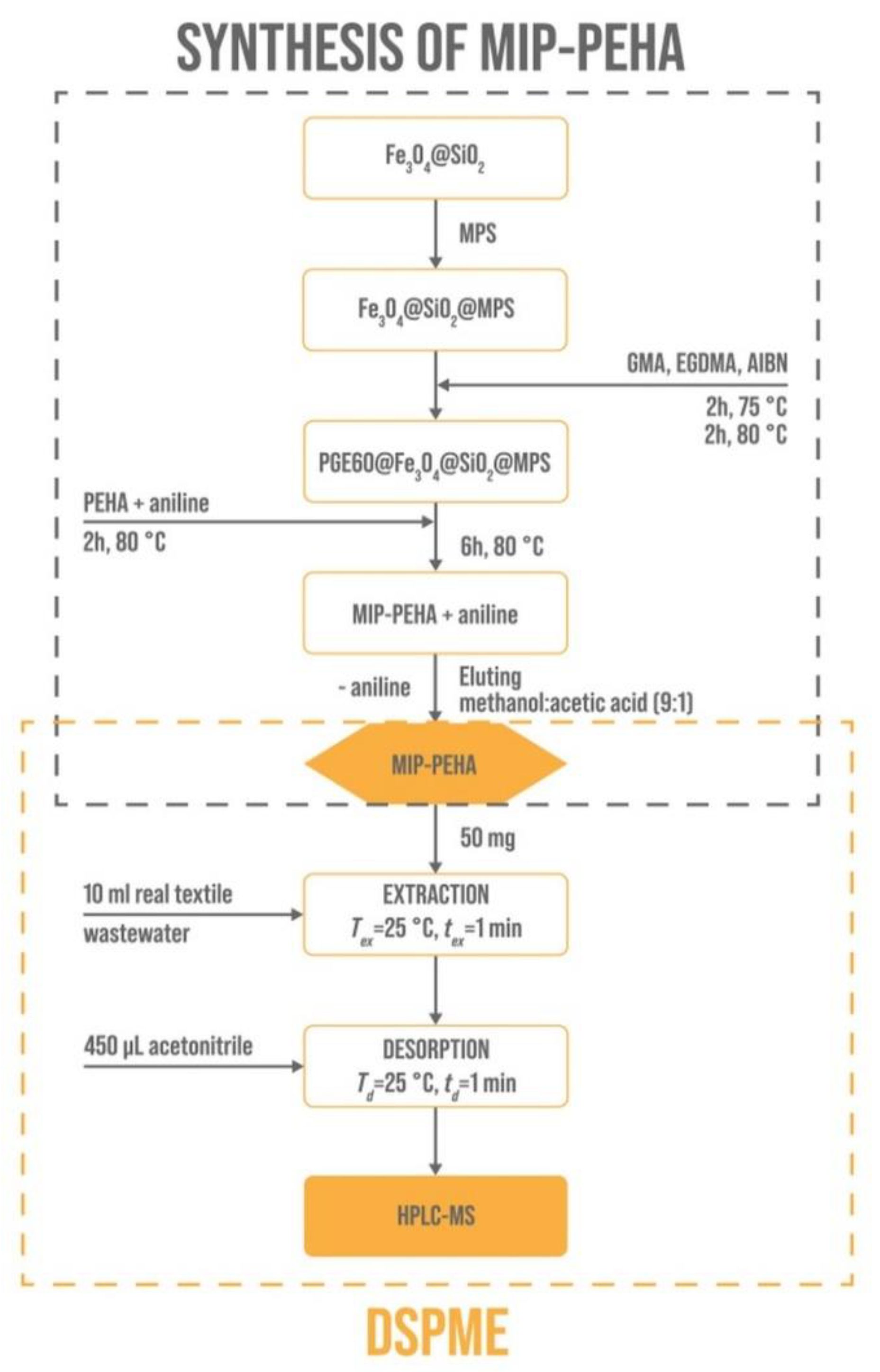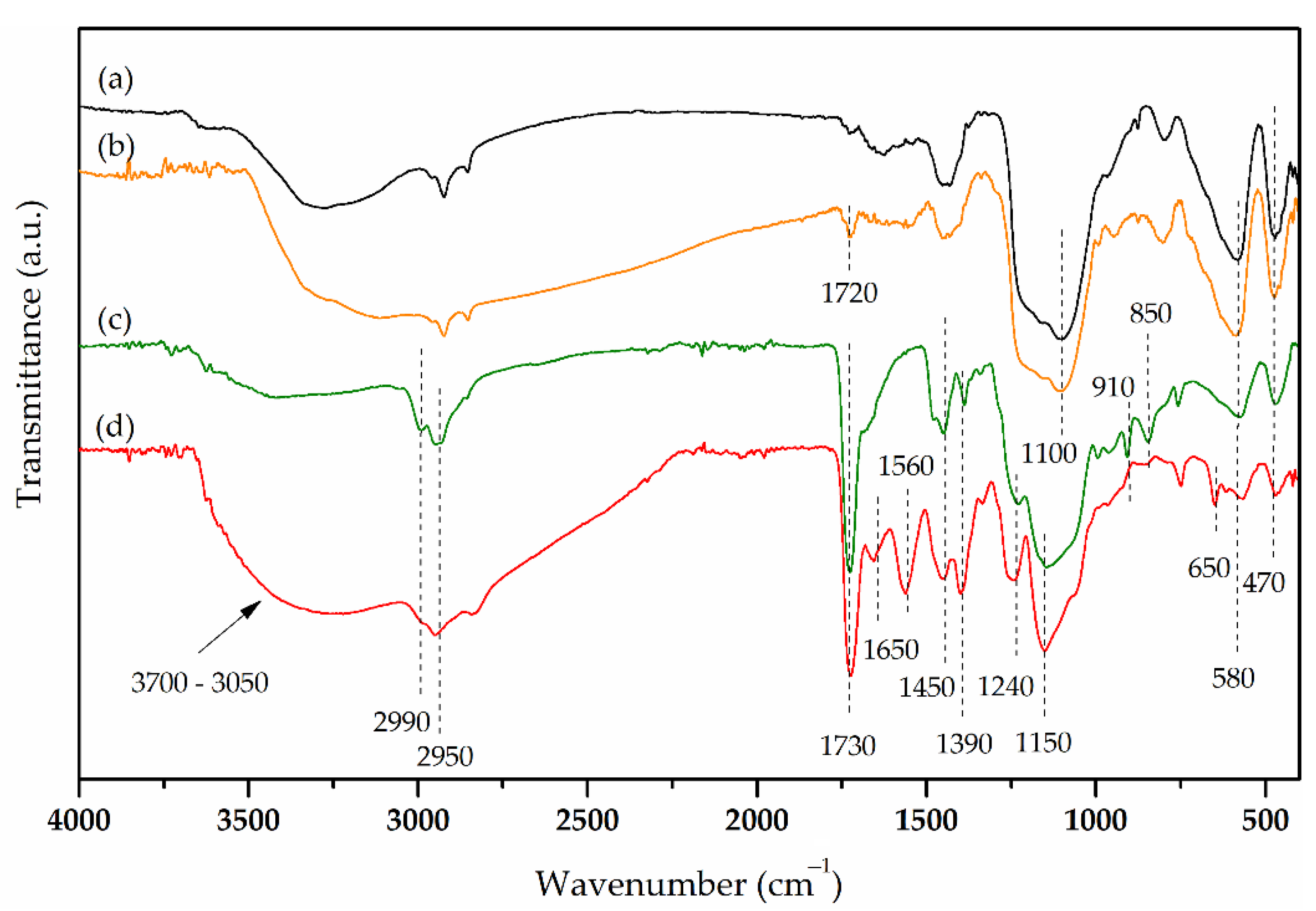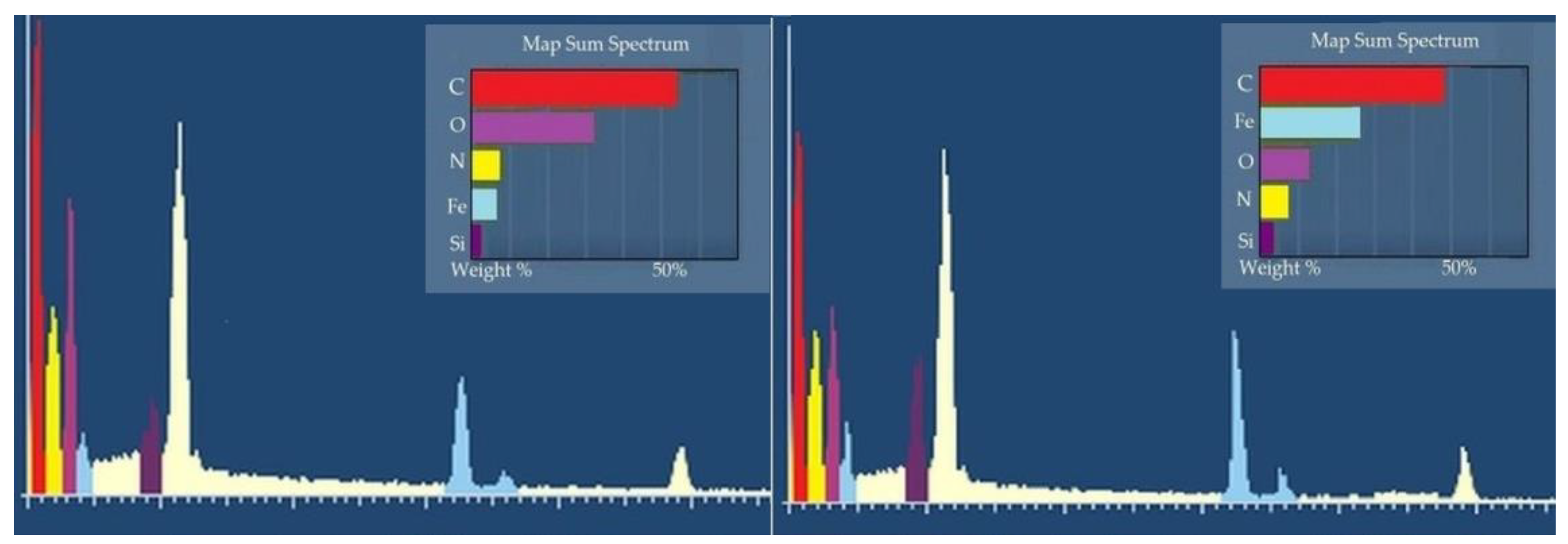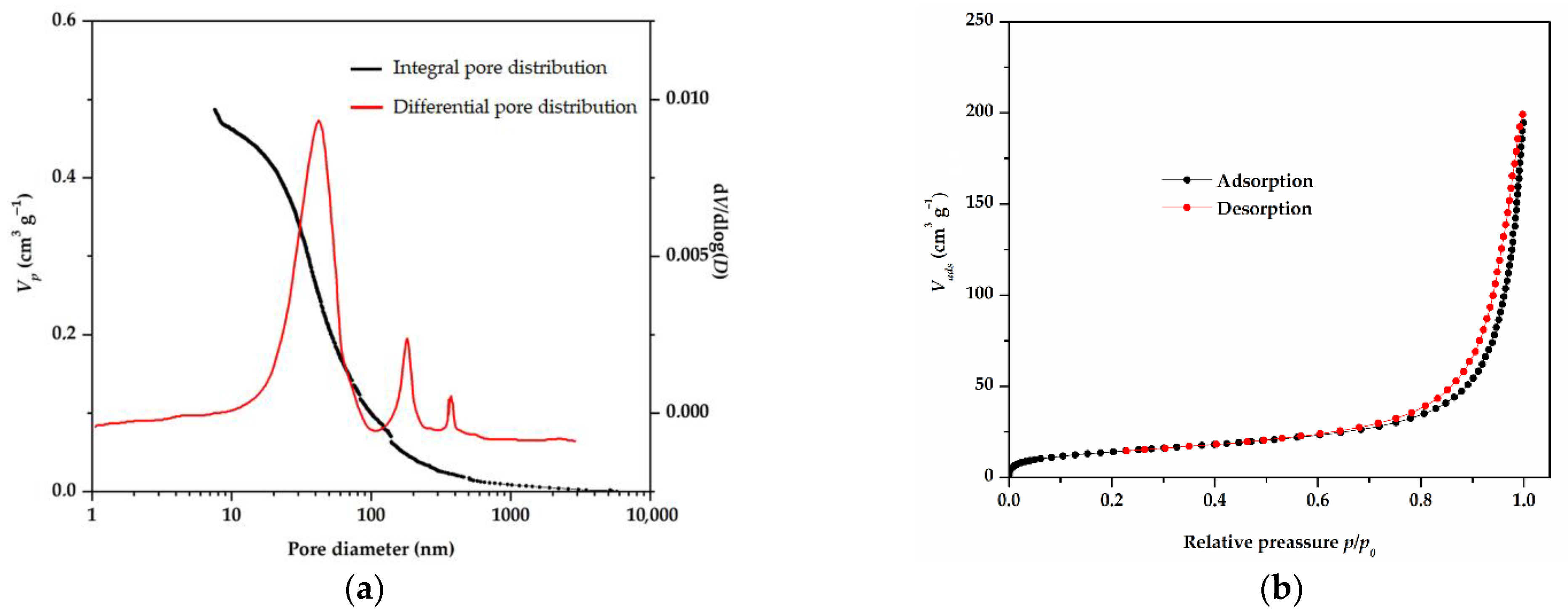A Core-Shell Amino-Functionalized Magnetic Molecularly Imprinted Polymer Based on Glycidyl Methacrylate for Dispersive Solid-Phase Microextraction of Aniline
Abstract
:1. Introduction
2. Materials and Methods
2.1. Chemicals
2.2. Instrumentation
2.3. Synthesis of Core-Shell Amino-Functionalized MIP
2.3.1. Coating of Magnetite Nanoparticles with TEOS and MPS
2.3.2. Synthesis of PGE60@Fe3O4@SiO2@MPS Support
2.3.3. Synthesis of PEHA Functionalized MIP
2.4. Dispersive Solid-Phase Microextraction
2.4.1. Plackett–Burman Design for the Screening of the Significant Variables
2.4.2. Optimization of Significant Variables by Box–Behnken Design
3. Results and Discussion
3.1. Characterization of Core-Shell Amino-Functionalized MIP
3.2. Dispersive Solid-Phase Microextraction
3.2.1. MIP-DSPME Procedure Screening
3.2.2. MIP-DSPME Procedure Optimization
3.2.3. MIP-DSPME-HPLC method Validation
3.3. Comparison to Other Methods
3.4. Determination of Aniline in Real Wastewater Samples
4. Conclusions
Author Contributions
Funding
Institutional Review Board Statement
Informed Consent Statement
Data Availability Statement
Conflicts of Interest
References
- Xue, G.; Wang, Q.; Qian, Y.; Gao, P.; Su, Y.; Liu, Z.; Chen, H.; Li, X.; Chen, J. Simultaneous Removal of Aniline, Antimony and Chromium by ZVI Coupled with H2O2: Implication for Textile Wastewater Treatment. J. Hazard. Mater. 2019, 368, 840–848. [Google Scholar] [CrossRef] [PubMed]
- Ozmen, E.Y.; Sezgin, M.; Yilmaz, A.; Yilmaz, M. Synthesis of β-Cyclodextrin and Starch Based Polymers for Sorption of Azo Dyes from Aqueous Solutions. Bioresour. Technol. 2008, 99, 526–531. [Google Scholar] [CrossRef]
- Tadrent, S.; Khelfa, A.; Len, C. Effect of KOH Pretreatment on Lignocellulosic Waste for the Reduction of Nitrobenzene to Aniline without Metal. Sustainability 2020, 12, 4665. [Google Scholar] [CrossRef]
- Benkhaya, S.; M’rabet, S.; El Harfi, A. Classifications, Properties, Recent Synthesis and Applications of Azo Dyes. Heliyon 2020, 6, e03271. [Google Scholar] [CrossRef] [PubMed] [Green Version]
- Trujillo-González, J.; Mahecha-Pulido, J.; Torres-Mora, M.; Brevik, E.; Keesstra, S.; Jiménez-Ballesta, R. Impact of Potentially Contaminated River Water on Agricultural Irrigated Soils in an Equatorial Climate. Agriculture 2017, 7, 52. [Google Scholar] [CrossRef] [Green Version]
- Rubinos, D.A.; Spagnoli, G. Utilization of Waste Products as Alternative Landfill Liner and Cover Materials—A Critical Review. Crit. Rev. Environ. Sci. Technol. 2018, 48, 376–438. [Google Scholar] [CrossRef]
- Egbueri, J.C.; Ukah, B.U.; Ubido, O.E.; Unigwe, C.O. A Chemometric Approach to Source Apportionment, Ecological and Health Risk Assessment of Heavy Metals in Industrial Soils from Southwestern Nigeria. Int. J. Environ. Anal. Chem. 2020, 100, 1–19. [Google Scholar] [CrossRef]
- Xu, J.; Liu, Y.; Zhu, C.; Jia, H.; Tian, C.; Ma, H.; Lv, G. NaCl Improves Suaeda Salsa Aniline Tolerance in Wastewater. Sustainability 2020, 12, 7457. [Google Scholar] [CrossRef]
- U.S.EPA. Integrated Risk Information System (IRIS) Chemical Assessment Summary (Aniline). Available online: https://iris.epa.gov/static/pdfs/0350_summary.pdf (accessed on 26 July 2022).
- Habila, M.A.; Alhenaki, B.; El-Marghany, A.; Sheikh, M.; Ghfar, A.A.; ALOthman, Z.A.; Soylak, M. Metal Organic Framework-Based Dispersive Solid-Phase Microextraction of Carbaryl from Food and Water Prior to Detection by Ultra-Performance Liquid Chromatography-Tandem Mass Spectrometry. Separations 2022, 9, 32. [Google Scholar] [CrossRef]
- Abughrin, S.E.; Alshana, U.; Bakirdere, S. Magnetic Nanoparticle-Based Dispersive Solid-Phase Microextraction of Three UV Blockers Prior to Their Determination by HPLC-DAD. Int. J. Environ. Res. Public Health 2022, 19, 6037. [Google Scholar] [CrossRef]
- Ansari, S.; Masoum, S. A Multi-Walled Carbon Nanotube-Based Magnetic Molecularly Imprinted Polymer as a Highly Selective Sorbent for Ultrasonic-Assisted Dispersive Solid-Phase Microextraction of Sotalol in Biological Fluids. Analyst 2018, 143, 2862–2875. [Google Scholar] [CrossRef] [PubMed]
- Ariani, M.D.; Zuhrotun, A.; Manesiotis, P.; Hasanah, A.N. Magnetic Molecularly Imprinted Polymers: An Update on Their Use in the Separation of Active Compounds from Natural Products. Polymers 2022, 14, 1389. [Google Scholar] [CrossRef] [PubMed]
- Tolkou, A.K.; Kyzas, G.Z.; Katsoyiannis, I.A. Arsenic(III) and Arsenic(V) Removal from Water Sources by Molecularly Imprinted Polymers (MIPs): A Mini Review of Recent Developments. Sustainability 2022, 14, 5222. [Google Scholar] [CrossRef]
- Kusumkar, V.V.; Galamboš, M.; Viglašová, E.; Daňo, M.; Šmelková, J. Ion-Imprinted Polymers: Synthesis, Characterization, and Adsorption of Radionuclides. Materials 2021, 14, 1083. [Google Scholar] [CrossRef] [PubMed]
- Ansari, S. Application of Magnetic Molecularly Imprinted Polymer as a Versatile and Highly Selective Tool in Food and Environmental Analysis: Recent Developments and Trends. TrAC Trends Anal. Chem. 2017, 90, 89–106. [Google Scholar] [CrossRef]
- Ali, G.K.; Omer, K.M. Molecular Imprinted Polymer Combined with Aptamer (MIP-Aptamer) as a Hybrid Dual Recognition Element for Bio(Chemical) Sensing Applications. Review. Talanta 2022, 236, 122878. [Google Scholar] [CrossRef]
- Dil, E.A.; Doustimotlagh, A.H.; Javadian, H.; Asfaram, A.; Ghaedi, M. Nano-Sized FeO@SiO-Molecular Imprinted Polymer as a Sorbent for Dispersive Solid-Phase Microextraction of Melatonin in the Methanolic Extract of, Biological, and Water Samples. Talanta 2021, 221, 121620. [Google Scholar] [CrossRef]
- Zengin, A.; Badak, M.U.; Aktas, N. Selective Separation and Determination of Quercetin from Red Wine by Molecularly Imprinted Nanoparticles Coupled with HPLC and Ultraviolet Detection. J. Sep. Sci. 2018, 41, 3459–3466. [Google Scholar] [CrossRef] [PubMed]
- Tadić, T.; Marković, B.; Suručić, L.; Nastasović, A.; Onjia, A. Primena senzora na bazi molekulski otisnutih polimera za detekciju virusa. Ecologica 2021, 28, 543–550. [Google Scholar] [CrossRef]
- Elmasry, M.R.; Tawfik, S.M.; Kattaev, N.; Lee, Y.-I. Ultrasensitive Detection and Removal of Carbamazepine in Wastewater Using UCNPs Functionalized with Thin-Shell MIPs. Microchem. J. 2021, 170, 106674. [Google Scholar] [CrossRef]
- Sabri, M.A.; Sara, Z.; Al-Sayah, M.H.; Ibrahim, T.H.; Khamis, M.I.; El-Kadri, O.M. Simultaneous Adsorption and Reduction of Cr(VI) to Cr(III) in Aqueous Solution Using Nitrogen-Rich Aminal Linked Porous Organic Polymers. Sustainability 2021, 13, 923. [Google Scholar] [CrossRef]
- Hasanah, A.N.; Safitri, N.; Zulfa, A.; Neli, N.; Rahayu, D. Factors Affecting Preparation of Molecularly Imprinted Polymer and Methods on Finding Template-Monomer Interaction as the Key of Selective Properties of the Materials. Molecules 2021, 26, 5612. [Google Scholar] [CrossRef] [PubMed]
- Nastasović, A.; Marković, B.; Suručić, L.; Onjia, A. Methacrylate-Based Polymeric Sorbents for Recovery of Metals from Aqueous Solutions. Metals 2022, 12, 814. [Google Scholar] [CrossRef]
- Suručić, L.; Tadić, T.; Janjić, G.; Marković, B.; Nastasović, A.; Onjia, A. Recovery of Vanadium (V) Oxyanions by a Magnetic Macroporous Copolymer Nanocomposite Sorbent. Metals 2021, 11, 1777. [Google Scholar] [CrossRef]
- Sandić, Z.P.; Nastasović, A.B.; Jović-Jovičić, N.P.; Milutinović-Nikolić, A.D.; Jovanović, D.M. Sorption of Textile Dye from Aqueous Solution by Macroporous Amino-Functionalized Copolymer. J. Appl. Polym. Sci. 2011, 121, 234–242. [Google Scholar] [CrossRef]
- Fontanals, N.; Marcé, R.M.; Borrull, F. Materials for Solid-Phase Extraction of Organic Compounds. Separations 2019, 6, 56. [Google Scholar] [CrossRef] [Green Version]
- Li, H.; Hu, X.; Zhang, Y.; Shi, S.; Jiang, X.; Chen, X. High-Capacity Magnetic Hollow Porous Molecularly Imprinted Polymers for Specific Extraction of Protocatechuic Acid. J. Chromatogr. A 2015, 1404, 21–27. [Google Scholar] [CrossRef]
- Parisi, O.I.; Cirillo, G.; Curcio, M.; Puoci, F.; Iemma, F.; Spizzirri, U.G.; Picci, N. Surface Modifications of Molecularly Imprinted Polymers for Improved Template Recognition in Water Media. J. Polym. Res. 2010, 17, 355–362. [Google Scholar] [CrossRef]
- Ghosh, S.; Saha, S.; Sengupta, D.; Chattopadhyay, S.; De, G.; Basu, B. Stabilized Cu2O Nanoparticles on Macroporous Polystyrene Resins [Cu2O@ARF]: Improved and Reusable Heterogeneous Catalyst for On-Water Synthesis of Triazoles via Click Reaction. Ind. Eng. Chem. Res. 2017, 56, 11726–11733. [Google Scholar] [CrossRef]
- Prabu, D.; Senthil Kumar, P.; Indraganti, S.; Sathish, S.; Aravind Kumar, J.; Vijai Anand, K. One-Step Fabrication of Amino-Functionalized Fe3O4@SiO2 Core-Shell Magnetic Nanoparticles as a Potential Novel Platform for Removal of Cadmium (II) from Aqueous Solution. Sustainability 2022, 14, 2290. [Google Scholar] [CrossRef]
- Egbosiuba, T.C.; Abdulkareem, A.S.; Tijani, J.O.; Ani, J.I.; Krikstolaityte, V.; Srinivasan, M.; Veksha, A.; Lisak, G. Taguchi Optimization Design of Diameter-Controlled Synthesis of Multi Walled Carbon Nanotubes for the Adsorption of Pb(II) and Ni(II) from Chemical Industry Wastewater. Chemosphere 2021, 266, 128937. [Google Scholar] [CrossRef] [PubMed]
- Beres, D.L.; Hawkins, D.M. Plackett–Burman Technique for Sensitivity Analysis of Many-Parametered Models. Ecol. Model. 2001, 141, 171–183. [Google Scholar] [CrossRef]
- Marrubini, G.; Dugheri, S.; Cappelli, G.; Arcangeli, G.; Mucci, N.; Appelblad, P.; Melzi, C.; Speltini, A. Experimental Designs for Solid-Phase Microextraction Method Development in Bioanalysis: A Review. Anal. Chim. Acta 2020, 1119, 77–100. [Google Scholar] [CrossRef]
- Dozein, S.V.; Masrournia, M.; Es’haghi, Z.; Bozorgmehr, M.R. Development of a New Magnetic Dispersive Solid-Phase Microextraction Coupled with GC-MS for the Determination of Five Organophosphorus Pesticides from Vegetable Samples. Food Anal. Methods 2021, 14, 674–686. [Google Scholar] [CrossRef]
- Sefaty, B.; Masrournia, M.; Es’haghi, Z.; Bozorgmehr, M.R. Determination of Tramadol and Fluoxetine in Biological and Water Samples by Magnetic Dispersive Solid-Phase Microextraction (MDSPME) with Gas Chromatography—Mass Spectrometry (GC-MS). Anal. Lett. 2021, 54, 884–902. [Google Scholar] [CrossRef]
- Slavković-Beškoski, L.; Ignjatović, L.; Bolognesi, G.; Maksin, D.; Savić, A.; Vladisavljević, G.; Onjia, A. Dispersive Solid–Liquid Microextraction Based on the Poly(HDDA)/Graphene Sorbent Followed by ICP-MS for the Determination of Rare Earth Elements in Coal Fly Ash Leachate. Metals 2022, 12, 791. [Google Scholar] [CrossRef]
- Ferreira, S.L.C.; Bruns, R.E.; Ferreira, H.S.; Matos, G.D.; David, J.M.; Brandao, G.C.; Souza, A.S. Box-Behnken Design: An Alternative for the Optimization of Analytical Methods. Anal. Chim. Acta 2007, 597, 179–186. [Google Scholar] [CrossRef] [PubMed]
- Abdulrasheed, M.; Zulkharnain, A.; Zakaria, N.N.; Roslee, A.F.A.; Abdul Khalil, K.; Napis, S.; Convey, P.; Gomez-Fuentes, C.; Ahmad, S.A. Response Surface Methodology Optimization and Kinetics of Diesel Degradation by a Cold-Adapted Antarctic Bacterium, Arthrobacter Sp. Strain AQ5-05. Sustainability 2020, 12, 6966. [Google Scholar] [CrossRef]
- Egbosiuba, T.C.; Abdulkareem, A.S.; Kovo, A.S.; Afolabi, E.A.; Tijani, J.O.; Roos, W.D. Enhanced Adsorption of As(V) and Mn(VII) from Industrial Wastewater Using Multi-Walled Carbon Nanotubes and Carboxylated Multi-Walled Carbon Nanotubes. Chemosphere 2020, 254, 126780. [Google Scholar] [CrossRef]
- Vasiljević, T.; Onjia, A.; Čokeša, Đ.; Laušević, M. Optimization of Artificial Neural Network for Retention Modeling in High-Performance Liquid Chromatography. Talanta 2004, 64, 785–790. [Google Scholar] [CrossRef]
- Lukić, J.; Radulović, J.; Lučić, M.; Đurkić, T.; Onjia, A. Chemometric Optimization of Solid-Phase Extraction Followed by Liquid Chromatography-Tandem Mass Spectrometry and Probabilistic Risk Assessment of Ultraviolet Filters in an Urban Recreational Lake. Front. Environ. Sci. 2022, 10, 916916. [Google Scholar] [CrossRef]
- Javaheri, F.; Hassanajili, S. Synthesis of Fe3O4@SiO2@MPS@P4VP Nanoparticles for Nitrate Removal from Aqueous Solutions. J. Appl. Polym. Sci. 2016, 133, 44330. [Google Scholar] [CrossRef]
- Marković, B.M.; Vuković, Z.M.; Spasojević, V.V.; Kusigerski, V.B.; Pavlović, V.B.; Onjia, A.E.; Nastasović, A.B. Selective Magnetic GMA Based Potential Sorbents for Molybdenum and Rhenium Sorption. J. Alloys Compd. 2017, 705, 38–50. [Google Scholar] [CrossRef] [Green Version]
- Thommes, M.; Kaneko, K.; Neimark, A.V.; Olivier, J.P.; Rodriguez-Reinoso, F.; Rouquerol, J.; Sing, K.S.W. Physisorption of Gases, with Special Reference to the Evaluation of Surface Area and Pore Size Distribution (IUPAC Technical Report). Pure Appl. Chem. 2015, 87, 1051–1069. [Google Scholar] [CrossRef] [Green Version]
- Fakhri, A. Adsorption Characteristics of Graphene Oxide as a Solid Adsorbent for Aniline Removal from Aqueous Solutions: Kinetics, Thermodynamics and Mechanism Studies. J. Saudi Chem. Soc. 2017, 21, S52–S57. [Google Scholar] [CrossRef] [Green Version]
- Vadukumpully, S. Carbon Nanofibers Extracted from Soot as a Sorbent for the Determination of Aromatic Amines from Wastewater Effluent Samples. J. Chromatogr. A 2011, 1218, 3581–3587. [Google Scholar] [CrossRef]
- Zhang, Y.; Duan, Y. A Double-Functionalized Polymeric Ionic Liquid Used as Solid-Phase Microextraction Coating for Efficient Aromatic Amine Extraction and Detection with Gas Chromatography–Mass Spectrometry. Anal. Bioanal. Chem. 2019, 411, 2209–2221. [Google Scholar] [CrossRef]
- Reddynoone, K.; Jain, A.; Verma, K. Liquid-Phase Microextraction and GC for the Determination of Primary, Secondary and Tertiary Aromatic Amines as Their Iodo-Derivatives. Talanta 2007, 73, 684–691. [Google Scholar] [CrossRef]
- Chen, M.; Yin, Y.; Tai, C.; Zhang, Q.; Liu, J.; Hu, J.; Jiang, G. Analyses of Nitrobenzene, Benzene and Aniline in Environmental Water Samples by Headspace Solid Phase Microextraction Coupled with Gas Chromatography-Mass Spectrometry. Chin. Sci. Bull. 2006, 51, 1648–1651. [Google Scholar] [CrossRef]
- Chen, S.; Liang, H.; Han, D. Determination of Aniline Derivatives in Water Samples by High Performance Liquid Chromatography Coupled with On-Line Flow Injection Preconcentration. Anal. Lett. 2010, 43, 2349–2355. [Google Scholar] [CrossRef]
- Cai, M.-Q.; Wei, X.-Q.; Du, C.-H.; Ma, X.-M.; Jin, M.-C. Novel Amphiphilic Polymeric Ionic Liquid-Solid Phase Micro-Extraction Membrane for the Preconcentration of Aniline as Degradation Product of Azo Dye Orange G under Sonication by Liquid Chromatography–Tandem Mass Spectrometry. J. Chromatogr. A 2014, 1349, 24–29. [Google Scholar] [CrossRef]
- Amiri, A.; Baghayeri, M.; Nori, S. Magnetic Solid-Phase Extraction Using Poly(Para-Phenylenediamine) Modified with Magnetic Nanoparticles as Adsorbent for Analysis of Monocyclic Aromatic Amines in Water and Urine Samples. J. Chromatogr. A 2015, 1415, 20–26. [Google Scholar] [CrossRef] [PubMed]
- Wang, Z.; Liao, Y.; Chen, L.; Huang, X. On-Site Sample Preparation of Trace Aromatic Amines in Environmental Waters with Monolith-Based Multichannel in-Tip Microextraction Apparatus Followed by HPLC Determination. Talanta 2020, 220, 121423. [Google Scholar] [CrossRef] [PubMed]
- Ai, Y.; Zhao, F.; Zeng, B. Novel Proton-Type Ionic Liquid Doped Polyaniline for the Headspace Solid-Phase Microextraction of Amines. Anal. Chim. Acta 2015, 880, 60–66. [Google Scholar] [CrossRef] [PubMed]








| Variables | Symbol | Level | |
|---|---|---|---|
| Low | High | ||
| Dose of sorbent (mg) | m | 10 | 50 |
| pH | pH | 2 | 10 |
| Ionic strength (% w/v) | NaCl | 0 | 1 |
| Vortex or Ultrasonic extraction | Uex | Vor | Us |
| Extraction time (min) | tex | 1 | 5 |
| Extraction temperature (°C) | Tex | 10 | 40 |
| Desorption solvent volume (µL) | Vs | 200 | 700 |
| Desorption temperature (°C) | Td | 10 | 40 |
| Vortex or Ultrasonic desorption | Ud | Vor | Us |
| Desorption time (min) | td | 1 | 5 |
| Type of eluent | Solv | Me | Ac |
| Variables | Symbol | Level | |
|---|---|---|---|
| Low | High | ||
| Desorption solvent volume (μL) | Vs | 200 | 700 |
| pH | pH | 2 | 10 |
| Extraction temperature (°C) | Tex | 10 | 40 |
| Methods | Extraction Phase | Linear Range (ng mL−1) | LoD (ng mL−1) | Total tex (min) | Reference |
|---|---|---|---|---|---|
| SPME-LC/MS-MS | Amphiphilic polymeric ionic liquid membrane | 0.5–10 | 0.25 | 33 | [52] |
| SPME-GC-MS | Poly(1-ethoxyethyl-3-(4-vinyl-phenyl)imidazolium chloride) fiber | 0.05–10 | 4.29 | 40 | [48] |
| SPE (a)-GC-FID | Poly(p-phenylenediamine)-Fe3O4 nanocomposite | 0.03–100 | 0.007 | 2.5 | [53] |
| SDME-GC-FID | Toluene | 4–800 | 21 | 15 | [49] |
| ITMA/HPLC-DAD (b) | poly(4-vinylbenzoic acid-co-dimethacrylate/divinylbenzene) monolith | 0.1–300 | 0.026 | 21 | [54] |
| HS-SPME/GC-MS | Polydimethylsioxane fibers | 4.4–704 | 1.00 | 10 | [50] |
| SPE-HPLC | Cigarette filter | 0.025–10.0 | 5.46 | 7 | [51] |
| HS-SPME/ GC-MS | Proton-type ionic liquid-doped polyaniline | 0.195–100 | 0.024 | 42 | [55] |
| DSPME-HPLC-MS | Amino-functionalized magnetic molecularly imprinted polymer based on glycidyl methacrylate | 1–200 | 1.00 | 2 | This study |
Publisher’s Note: MDPI stays neutral with regard to jurisdictional claims in published maps and institutional affiliations. |
© 2022 by the authors. Licensee MDPI, Basel, Switzerland. This article is an open access article distributed under the terms and conditions of the Creative Commons Attribution (CC BY) license (https://creativecommons.org/licenses/by/4.0/).
Share and Cite
Tadić, T.; Marković, B.; Radulović, J.; Lukić, J.; Suručić, L.; Nastasović, A.; Onjia, A. A Core-Shell Amino-Functionalized Magnetic Molecularly Imprinted Polymer Based on Glycidyl Methacrylate for Dispersive Solid-Phase Microextraction of Aniline. Sustainability 2022, 14, 9222. https://doi.org/10.3390/su14159222
Tadić T, Marković B, Radulović J, Lukić J, Suručić L, Nastasović A, Onjia A. A Core-Shell Amino-Functionalized Magnetic Molecularly Imprinted Polymer Based on Glycidyl Methacrylate for Dispersive Solid-Phase Microextraction of Aniline. Sustainability. 2022; 14(15):9222. https://doi.org/10.3390/su14159222
Chicago/Turabian StyleTadić, Tamara, Bojana Marković, Jelena Radulović, Jelena Lukić, Ljiljana Suručić, Aleksandra Nastasović, and Antonije Onjia. 2022. "A Core-Shell Amino-Functionalized Magnetic Molecularly Imprinted Polymer Based on Glycidyl Methacrylate for Dispersive Solid-Phase Microextraction of Aniline" Sustainability 14, no. 15: 9222. https://doi.org/10.3390/su14159222
APA StyleTadić, T., Marković, B., Radulović, J., Lukić, J., Suručić, L., Nastasović, A., & Onjia, A. (2022). A Core-Shell Amino-Functionalized Magnetic Molecularly Imprinted Polymer Based on Glycidyl Methacrylate for Dispersive Solid-Phase Microextraction of Aniline. Sustainability, 14(15), 9222. https://doi.org/10.3390/su14159222









